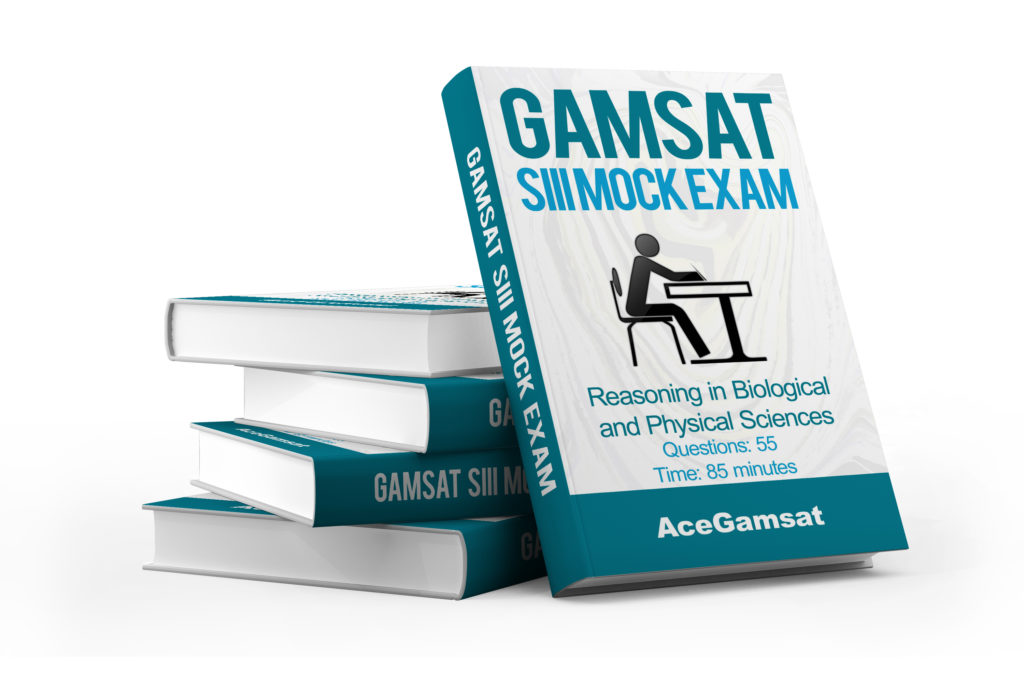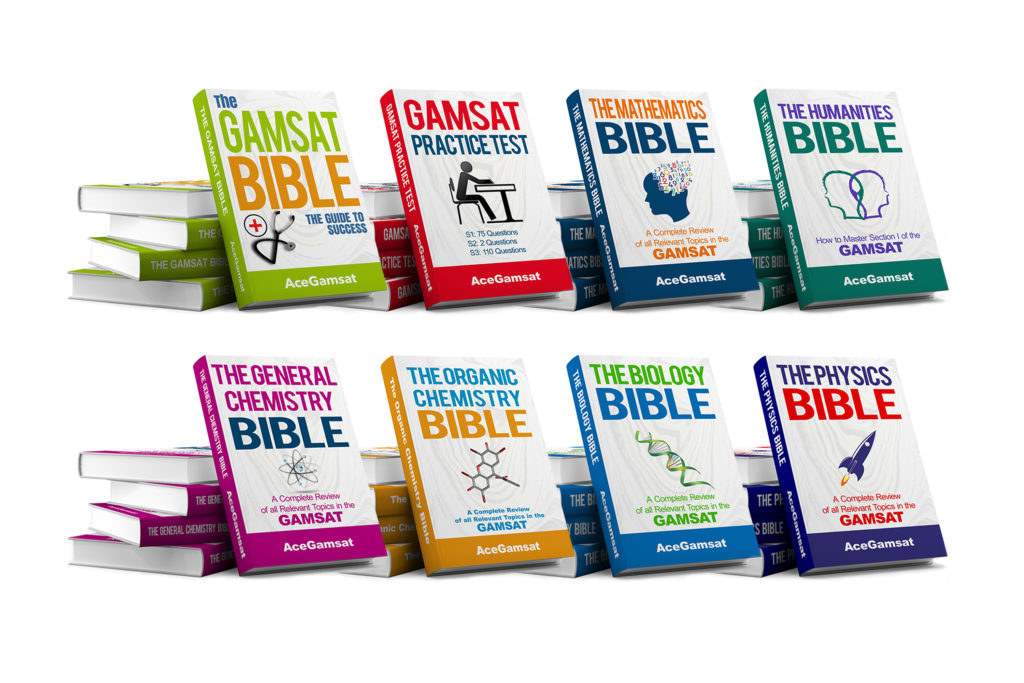
From: Matthew
Re: How To Prepare For GAMSAT
Okay, so you want to know how to prepare for GAMSAT? Well, firstly the GAMSAT is a prerequisite test run by ACER for the admission into dental and medical schools in Australia, Ireland, and the UK.
There are 3 sections in the GAMSAT.
Section 1
This section is called Reasoning in Humanities and Social Sciences. Students are given 100 minutes to complete 75 multiple-choice questions.
Section 2
This is the Written Communication section.
Students are given essay Task A and B to complete in 60 minutes total.
Section 3
This is called the Reasoning in Biological and Physical Sciences section. Students are given 170 minutes to complete 110 multiple-choice questions.
Before we start I would like to announce that you can get your free GAMSAT questions by clicking the link below:
Free GAMSAT Practice Test
Now we will get into the valuable content!
How to prepare for GAMSAT Section 1?
Section 1
For this section students should be familiar with the following types of texts as these are likely to come up in the exam – essays, poems, cartoons, dramas, editorials, graphs, figures, short stories, essays, letters, journals, and biographies. All of these types of stimulus material can be categorised into the following 4 categories:
1. Prose (in all diverse types)
2. Poetry (including Drama)
3. Social and/or Behavioural Sciences
4. Editorial Cartoon and/or Graphic Representations
An in-depth analysis of these different categories are covered in detail in The Humanities Bible.
The Humanities Bible provides over 75 questions and solutions for all of the categories.
Regular reading and practice are the most effective ways to prepare for this section. An e-book reader is a worthy investment. E-books can easily be downloaded through the Amazon store and unfamiliar words can easily be learnt via the inbuilt dictionary. This is a great way to improve your vocabulary through reading.
Suggested Readings
Some great readings that will help prepare you for the type of texts you will receive in Section I include:
- The Great Gatsby – F. Scott Fitzgerald
- Defying Hitler – Sebastian Haffner
- English Passengers – Matthew Kneale
- Oliver Twist – Charles Dickens
- The Penguin Book of Twentieth Century Essays – Ian Hamilton
- A Short History of Nearly Everything – Bill Bryson
- The Story of My Life – Helen Keller
Vocabulary
Students should aim to improve their by utilising the tools on www.vocabulary.com. Students should practice questions from the MCAT word list.
Section-I-like questions can also be found on readtheory.org.
Our team has released a Full Length GAMSAT Practice Test, which is identical to the actual GAMSAT exam. Students should complete all of the Section I practice questions in this test. Students should then check all answers and go back and see where they went wrong. This is the most effective and fastest way to improve your score in Section I.
The 4 ACER booklets are also a must-have resource to practise your Section I comprehension skills.
How to prepare for GAMSAT Section 2?
Section 2
- In the exam, students are to complete two essays – both Task A and Task B.
- Essays should be at least 350 – 400 words.
- Five quotes are provided for each essay task and all of the quotes surround a common theme.
- Task A deals with socio-cultural issues and Task B deals with social and personal issues.
- A title is recommended for each essay. Be creative! The markers are looking for the best ideas. Ideas are more important than spelling, grammar, and punctuation.
- The best ideas get the best marks, so planning your essay in the first 5 minutes is the key to success.
When planning your essay, read the series of 5 quotes carefully and determine the overall theme. The theme is quite obvious. Some examples of themes include: freedom, crime, poverty, wealth, punishment, science, technology, love, friendship, humour, suffering, youth, beauty, ageing, conformity, originality.
How to prepare for GAMSAT S2 – Task A
Task A is an argumentative essay. Each paragraph should be planned out.
Paragraph 1: Introduction – explanation and interpretation of a chosen quote or standpoint you have concerning the overall theme.
Students should aim for three body paragraphs. They should be Thesis, Thesis, Antithesis (or Thesis, Antithesis, Antithesis).
A concluding paragraph should then sum up and reconcile between the Thesis’ and Antithesis. Common themes that students could expect in the GAMSAT Task A include:
- Freedom
- Crime
- Poverty
- Wealth
- Punishment
- Science
- Technology
How to prepare for GAMSAT S2 – Task B
Task B is a personal essay. It should be written with feeling. Students need to be able to explain and visualise how other people may be feeling in different life situations.
The quotes that students receive have a personal theme, which allows students to relate the themes to their own experiences in life.
Paragraph 1: Acquaint the reader with the topic/theme and state your specific point of view.
There should be 3 body paragraphs. Each paragraph should focus on a different idea that supports your specific point of view.
A concluding paragraph should summarise the main points, then support the main view and end with a great impact on the reader.
Common topics that students can expect in the GAMSAT Task B:
- Love
- Friendship
- Humour
- Suffering
- Youth
- Beauty
- Conformity
- Originality
- Ageing
How to prepare for GAMSAT Section 3?
Section 3
This section of the GAMSAT includes physics at year 12 level and biology, general chemistry, and organic chemistry all at university level. The exam consists of 20% organic chemistry, 20% physics, 20% general chemistry, and 40% biology.
Candidates are required to use their knowledge and the understanding of concepts in order to answer questions. This section involves the analysis of tables, charts, scientific information, and graphs.
It is important that students practise questions under timed conditions. The ACER booklets are a great start for practice questions.
The AceGAMSAT team have released a ‘Full-Length GAMSAT Practice Test’ which contains 110 questions that are just like the real exam, so this is definitely a valuable resource.
If you want to know how to study for GAMSAT, then the following Section 3 topic list below is extremely valuable.
These refined topic points are covered in great detail in the respective AceGAMSAT study guides.
- The Biology Bible
- The Organic Chemistry Bible
- The General Chemistry Bible
- The Physics Bible
GAMSAT Biology Syllabus
Macromolecules
Carbohydrates
Nucleic acids
Proteins
Lipids
The Cell
Cell theory
Cell size
Visualisation of cells
Cell structure
Prokaryotes
Eukaryotes
Endomembrane system
Mitochondria and chloroplasts
Cytoskeleton
Cell movement
Fungi
Virus
The Cell Membrane
Structure
Phospholipids
Passive transport
Active transport
Endocytosis and exocytosis
Energy, Metabolism and Respiration
Adenosine triphosphate (ATP)
Cellular metabolism
Glycolysis
Aerobic respiration
Kreb’s Cycle
Electron transport chain
Enzymes
Mitosis and the Cell Cycle
Binary fission
Eukaryotic cell cycle
Interphase
M Phase
Sexual Reproduction and Meiosis
Stages of meiosis
Meiosis VS mitosis
Genetics
Overview
Mendel’s first law: The Law of Segregation
Incomplete dominance
Codominance
Punnett Squares
Mendel’s second law: The Law of Independent Assortment
Male VS female chromosomes
The Nervous System
Resting potential
Action potential
The synapse
Types of neurons
Divisions of the nervous system
The eye
The ear
The nose and mouth
The Endocrine System
Chemistry of hormones
Hormones in detail
Reproduction
Male reproductive system
Female reproductive system
The Digestive and Excretory System
Mouth and esophagus
The stomach
The small intestine
The pancreas
The liver and gall bladder
The large intestine
Absorption
The kidney
The Cardiovascular System
Anatomy of the cardiovascular system
Blood vessels
The blood
The Respiratory System
The Lymphatic System
The Immune System
Muscle
Skeletal muscle
Cardiac muscle
Smooth muscle
Bone
Cartilage
Joints
Skin
Homeostasis
GAMSAT Organic Chemistry Syllabus
Basic and Common Functional
Organic Chemistry Basics
Molecular Representations
3D bond-line structures
Identifying lone pairs of electrons resonance
Hybrid orbitals
Alkanes
Naming alkanes
Naming substituents
Constitutional Isomers of alkanes
Newman projections
Cyclohexane and chair conformations
Stereochemistry
Isomerism
Important concepts in stereoisomerism
Designating R and S
Relationships between enantiomers and diastereomers
Meso compounds
Fischer projections
Substitution Reactions
Alkyl halides
The SN2 mechanism
The SN1 mechanism
Elimination Reactions: Structure and Preparation of Alkenes
Nomenclature of alkenes
Stereoisomerism in alkenes
Elimination reactions
E2 reactions
E1 reactions
Addition Reactions
Hydrohalogenation
Hydration
Hydrogenation
Halogenation
Alkynes
Radical Reactions
Alcohols and Phenols
Physical properties of alcohols
Acidity of alcohols and phenols
Preparation of alcohols using Grignard reagents
Spectroscopy
Infrared spectroscopy
Nuclear Magnetic resonance spectroscopy
Aromatic Rings
Nomenclature of aromatic rings
Aromatic Substitution Reactions
Electrophilic aromatic substitution
Sulfonation
Nitration
Activating groups
Deactivating groups
Aldehydes and Ketones
Introduction
Nomenclature of aldehydes
Nomenclature of Ketones
Preparation of aldehydes and ketones
Important reactions of aldehydes and ketones
Carboxylic Acids
Nomenclature
Structure of carboxylic acids
Acidity of carboxylic acids
Preparation of carboxylic acids
Reactions of carboxylic acids
Amines
Classification
Nomenclature
Properties of amines
Preparation of amines
Important reactions of amines
Amino Acids, Peptides and Proteins
Introduction
Structure and properties of amino acids
Acid-Base properties
Peptide synthesis
Protein structure
Protein function
GAMSAT General Chemistry Syllabus
Atoms and Molecules
Atoms
Elements
The periodic table
Ions
Molecules
Naming inorganic compounds
Chemical reactions and equations
Types of Chemical Reactions
Oxidation numbers and redox reactions
Oxidising VS reducing agents
Gases
Kinetic molecular theory
Kinetics and chemical equilibrium
The collision theory
Equations for reaction rates
Determining the rate law by experiment
Reaction orders
Rates of reversible reactions
Catalysis
Equilibrium
The reaction quotient
Le Chatelier’s principle
Thermodynamics
The first law of thermodynamics
The second law of thermodynamics
Thermodynamic functions
Internal energy
Temperature
Pressure
Enthalpy
Entropy
Gibbs free energy
Solutions
Units of concentration
Vapor pressure
Solubility
Phase Diagrams
Acids and Bases
Definitions
Equilibrium constants for acid-base reactions
Logarithms
Titrations
Buffers
Electrochemistry
Oxidation-reduction
Potentials
Galvanic cells
Electrolytic cell
GAMSAT Physics Syllabus
Translational Motion
Scalars and vectors
Adding and subtracting vectors
Resolution of vectors and trigonometric functions
Distance and displacement
Speed and velocity
Acceleration
Uniform accelerated motion
Force, Motion, and Gravitation
Mass, weight, center of mass
Newton’s first law, second law, and third law
Gravitation
Special right triangles
Free fall motion
Projectile motion
Friction
Inclined planes
Circular motion and centripetal force
Tension
Pulley systems
Equilibrium
Translational and rotational motion
Momentum and Collisions
Energy and Work
Energy
Work
Energy conservation
Power
Fluids and Solids
Density
Specific gravity
Pressure
Buoyancy and Archimedes’ principle
Fluids in motion
Fluid viscosity and determination of flow
Surface tension
Solids
Wave Characteristics and Periodic Motion
Transverse and longitudinal mechanical waves
Mathematical representation of a wave
Superposition of waves, phase, interface
Resonance
Standing waves
Harmonics
Periodic motion
Sound
Production of sound
Intensity and pitch
Beats
Doppler effect
Electrostatistics
Charge, conductors, insulators
Coulomb’s law, electric force
Electric field, electric field lines
Potential energy
Equipotential lines and electric dipoles
Electromagnetism
Electromagnetism
Electromagnetic spectrum
Electricity: Electric Circuits
Current
Ohm’s law
Resistance and resistivity
Resistance in circuits
Batteries and electromotive force
Kirchoff’s laws
Capacitors and dielectrics
Power
Light and Optics
Visual spectrum and polarisation
Images
Mirrors
Refraction, dispersion, Snell’s law
Lenses
Atomic and Nuclear Structure
Protons, neutrons, electrons
Isotopes, atomic number, atomic weight
Fission and fusion
Radioactivity
Nuclear reactions and radioactive decay
Half-life
AceGAMSAT Products



